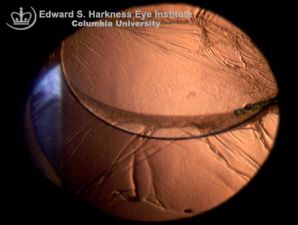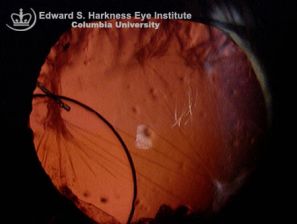Sunrise Syndrome
All content on Eyewiki is protected by copyright law and the Terms of Service. This content may not be reproduced, copied, or put into any artificial intelligence program, including large language and generative AI models, without permission from the Academy.
Sunrise syndrome and Sunset syndrome are IOL-related cataract surgery complications. resulting from malposition of the IOL.
Disease Entity
Disease
The term Sunrise Syndrome and/or Sunset Syndrome refers to the IOL-associated cataract complication, which often occurs early due to improper IOL fixation within the capsular bag, resulting in IOL misplacement.[1] It depends on haptics positioning and asymmetric bag-sulcus placement. Both can present later following ocular injury, capsular or zonular disruption and contracture.[2] Sunrise syndrome most commonly occurs due to the misplacement of the superior haptic in the ciliary sulcus, while the inferior one is placed into the capsular bag, that allows the IOL to subluxate superiorly. The direction and extent of the subluxation depends on haptics positioning and asymmetric bag-sulcus placement during surgery.[2] Sunset syndrome can develop when the opposite is true, when the inferior haptic is improperly placed in the ciliary sulcus. Alternatively, Sunset syndrome may occur from undetected anterior capsule rupture extending inferiorly allowing the inferior haptic of PCIOL to escape through the defect, leading to downward IOL displacement. When comparing to an IOL misplacement, a properly placed "lens in the bag complex" can sublux in any direction for a number of reasons with similar presentation and appearance. Dead Bag Syndrome can also present with lens subluxation.
Diagnosis
Symptoms
- fluctuating vision or progressive loss of vision - can be positional depending on lens stability.
- monocular diplopia
- glare
- halos
- photosensitivity
- optical aberrations
Management
Surgery
- Repositioning the lens from the capsular bag to the sulcus (for 3-piece IOLs).
- Rarely it has to be removed or replaced with secondary AC IOL or scleral fixated IOL implantation.
- Iris- or transcleral-sutures may be required to secure the IOL in position.[2]
- See Secondary Intraocular Lens for further information on management.
References
- ↑ S. Gregory Smith, Richard L. Lindstrom, Report and management of the sunrise syndrome, American Intra-Ocular Implant Society Journal, Volume 10, Issue 2, 1984, Pages 218-220, ISSN 0146-2776. https://doi.org/10.1016/S0146-2776(84)80120-2.
- ↑ Jump up to: 2.0 2.1 2.2 Columbia Ophthalmology, Department of Ophthalmology. (n.d.). Sunrise Syndrome. Sunrise Syndrome | Columbia Ophthalmology. https://www.columbiaeye.org/education/digital-reference-of-ophthalmology/lens-cataract/surgery-complications-0/sunrise-syndrome.




